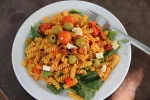Laurie --- In one sense, this is like asking someone how they think. We can help each other develop our thinking ability, including the patterns and rules of logical thought, but it's a whole lot more difficult to directly answer how we think.
Given, and speaking only for myself, I look for things that are relatively quick and easy to prepare, but that also look and taste appealing. I don't consider myself to be even an amateur chef, and I have no formal training, just years of experience and experimentation. Mostly, I just love to entertain others. Therefore, take my comments with a grain of salt (or a grind of salt, if you're willing to carry the extra weight).
A couple principles:
- One-pot and two-pot meals are best given the limited cookware selection at many albergues. Also, you often have to share the stove with other pilgrims.
- Saute/stir-fry/simmer and soup/sauce are your most common options. I would avoid frying. I saw relatively few steamers, although I would tend to use them whenever possible.
- Baking might be possible (almost no competition for the oven), such as for a casserole or some kind of roast meat, but make sure you have the proper cookware and the oven actually works (experience talking here).
- Focus on one or two courses of fresh dishes such as fruit salads, vegetable salads, possibly with seared or cooked meat (beef, chicken, seafood). Also, dress up a baguette with dipping oil (infuse with some roasted garlic and basil, etc.) and balsamic vinegar.
In my opinion, the trick with cooking from scratch, based on whatever is available at the store, is that experience is more important than creativity. If you experiment at home with different variations on a handful of basic recipes, that experience will be hugely useful when you walk into a supermercado and have to pick from their narrow selection. Start with a basic recipe, understand its basic elements and approach, and then start to experiment with different ingredients. By way of several examples:
- Risotto makes a great one-pan core meal with almost infinitely possible variations. There are tons of online recipes; once you get the hang of it, it's quite straightforward.
- A light and fresh option to the heavier sauces is a "margarita" approach --- fresh-diced tomatoes, garlic, and basil sauteed in olive oil forms the core, but onions, squash, diced peppers (or tinned pequillos), or paprika (or smoked paprika) make a nice addition. You can add some chile piquin or cayenne to give a little heat, or some fresh squeeze lemon juice. Shrimp, chicken, or chorizo all go with it. You can also saute any number of other vegetables if you want. Use it over pasta or rice, or place it on a toasted baguette that has been sliced in half, then grate some cheese (or thin cut slices) onto it and then put it in the oven to melt and toast the cheese.
- There are a number of light pestos and pesto-like sauces that can be used with pasta, vegetables, chicken, or bread.
Also, when you experiment, try to see what flavors go well together. For instance, Iberian ham typically goes very well with chicken. Diced, it also goes well in tomato dishes (sauces and sautes). Wrap it around brussel sprouts and saute, or diced with green beans. Fresh squeezed lemon and fresh thyme go great together with steamed or sauteed green vegetables. If you spend time looking at various recipe books, ignore the recipes and look for common ingredient pairings that help form the core taste of a thing. Look also for ingredients that appear to be "background" flavors that don't dominate but do add texture, depth, and complexity. Once you know how other people use things together, you have a basis for your own experimentation, which leads to experience and judgement.
As part of your experimentation, think of what is likely to be available along your route. In the US, we have pretty much everything all year round, but I suspect its far more seasonal and regional in most rural areas of Spain. Obviously, chorizo, cured ham, sometimes chicken and sometimes beef. I remember green beans, lettuce, spinach, tomatoes, onions, carrots, potatoes, squash, peppers (rarely hot), sometimes more exotics like broccoli and cauliflower and brussel sprouts. Garlic is a mainstay. Citrus, especially oranges and lemons, were common. Take every ingredient that you are likely to find, and Google search recipes that include that ingredient --> "recipe green beans". Typically, your hits will feature recipes built around that ingredient as the core ingredient, and that will help you learn how that ingredient is commonly used.
Note that above there is really no "creativity" being used, just experience and judgement informed by experimentation.
Here's a link to a
Camino recipe booklet. Some workable ideas inside.





















